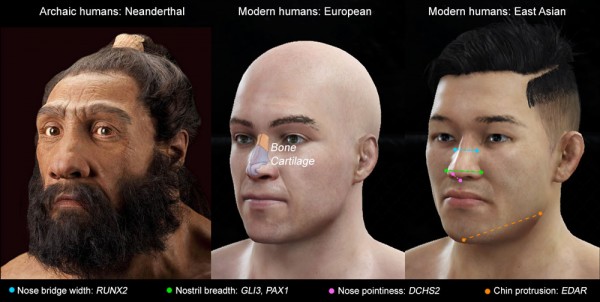Scientists Identify Genes That Determine Your Nose Shape
| Ana Verayo | | May 21, 2016 05:17 AM EDT |
(Photo : Kaustubh Adhikari, UCL) Image showing variation between nose shape and the specific genes responsible
Scientists have determined which genes that determine the appearance of one's nose. These four specific genes apparently dictate how your nose will be shaped, according to a new study.
Researchers examined the faces and analyzed the DNA of 6,000 individuals, where they determined factors such as breadth, pointiness, and other distinct characteristics. These genes are known as DCHS2, RUNX2, GLI3, and PAX1, where they are responsible for the width and pointiness of the nose. Another gene known as EDAR is discovered to influence the chin's jut.
Like Us on Facebook
These genes contribute to the nose's characteristics and growth of its bone and cartilage, including the overall shape of the face. More specifically, GLI3 which triggers cartilage growth has the largest influence on the shape of the nostrils. DCHS2 on the other hand is linked to the nose's pointiness and RUNX2 modifies bone growth and the width of the nose bridge.
Participants of this new study originate from South American countries that are mixed with ethnic populations. Half of this population is European, 45 percent were Native American and five percent has African ancestry.
The team also examined the photos of the volunteers to establish 14 different attributes such as nose bridge width, nose protrusion and nose tip shape. Using 3D computer simulations, their facial features were measured as well. Genetic data was then compared to each characteristic trait for any association.
According to lead author of the study Kaustubh Adhikari of the University College London, there are only a few studies that investigated how normal facial features develop and those that examined how European features develop, which only showed a little diversity compared to this new study.
Adhikari explains that these specific genes are the ones responsible for the shape and size of individual features that have not yet been identified before. By figuring out what each gene is responsible for, this can help further research to put the pieces of an evolutionary puzzle together, beginning from Neanderthals to modern humans.
Apart from understanding the way humans evolve through time, this can also provide new insight on how genes can greatly influence the way an individual looks, which has been crucial in forensics applications.
This new study is published in the journal Nature Communications.
Tagsnose shape, Genetics, nose, genes that determine nose shape
©2015 Chinatopix All rights reserved. Do not reproduce without permission
EDITOR'S PICKS
-

Did the Trump administration just announce plans for a trade war with ‘hostile’ China and Russia?
-

US Senate passes Taiwan travel bill slammed by China
-

As Yan Sihong’s family grieves, here are other Chinese students who went missing abroad. Some have never been found
-

Beijing blasts Western critics who ‘smear China’ with the term sharp power
-

China Envoy Seeks to Defuse Tensions With U.S. as a Trade War Brews
-

Singapore's Deputy PM Provides Bitcoin Vote of Confidence Amid China's Blanket Bans
-

China warns investors over risks in overseas virtual currency trading
-

Chinese government most trustworthy: survey
-

Kashima Antlers On Course For Back-To-Back Titles
MOST POPULAR
LATEST NEWS
Zhou Yongkang: China's Former Security Chief Sentenced to Life in Prison

China's former Chief of the Ministry of Public Security, Zhou Yongkang, has been given a life sentence after he was found guilty of abusing his office, bribery and deliberately ... Full Article
TRENDING STORY

China Pork Prices Expected to Stabilize As The Supplies Recover

Elephone P9000 Smartphone is now on Sale on Amazon India

There's a Big Chance Cliffhangers Won't Still Be Resolved When Grey's Anatomy Season 13 Returns

Supreme Court Ruled on Samsung vs Apple Dispute for Patent Infringement

Microsoft Surface Pro 5 Rumors and Release Date: What is the Latest?










